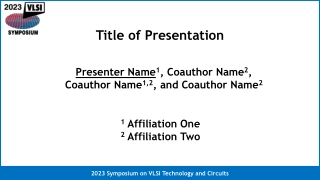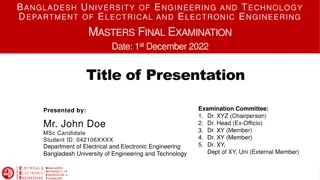Understanding Domain Name System (DNS) Resolver Operation and Debugging
The session explores the operation of Domain Name System (DNS) resolvers, focusing on how resolvers work, caching, and querying authoritative nameservers. It delves into the process of resolving queries, locating authoritative nameservers, handling cache misses, and the hierarchical structure of DNS. The content also discusses intermediate nameservers, referrals, and potential outcomes during the resolution process.
Download Presentation

Please find below an Image/Link to download the presentation.
The content on the website is provided AS IS for your information and personal use only. It may not be sold, licensed, or shared on other websites without obtaining consent from the author. Download presentation by click this link. If you encounter any issues during the download, it is possible that the publisher has removed the file from their server.
E N D
Presentation Transcript
Domain Name System (DNS) Session 2: Resolver Operation and debugging Michuki Mwangi AfNOG Workshop, AIS 2018, Dakar
How Resolvers Work (1) If we've dealt with this query before recently, answer is already in the cache - easy! Query Resolver Stub Resolver Response
What if the answer is not in the cache? DNS is a distributed database: parts of the tree (called "zones") are held in different servers They are called "authoritative" for their particular part of the tree It is the job of a caching nameserver to locate the right authoritative nameserver and get back the result It may have to ask other nameservers first to locate the one it needs
How caching NS works (2) Auth NS 2 1 Query 3 Auth NS Stub Resolver Resolver Response 4 5 Auth NS
How does it know which authoritative nameserver to ask? It follows the hierarchical tree structure e.g. to query "www.somnog.so" . (root) 1. Ask here so 2. Ask here somnog.so 3. Ask here ws.somnog.so 4. Ask here
Intermediate nameservers return "NS" resource records "I don't have the answer, but try these other nameservers instead" Called a REFERRAL Moves you down the tree by one or more levels
Eventually this process will either: Find an authoritative nameserver which knows the answer (positive or negative) Not find any working nameserver: SERVFAIL End up at a faulty nameserver - either cannot answer and no further delegation, or wrong answer! Note: the resolver may happen also to be an authoritative nameserver for a particular query. In that case it will answer immediately without asking anywhere else. We will see later why it's a better idea to have separate machines for caching and authoritative nameservers
How does this process start? Every caching nameserver is seeded with a list of root servers /etc/unbound/unbound.conf.d/root-hints.conf server: root-hints: /var/lib/unbound/named.root /var/lib/unbound/named.root . 3600000 NS A.ROOT-SERVERS.NET. A.ROOT-SERVERS.NET. 3600000 A 198.41.0.4 . 3600000 NS B.ROOT-SERVERS.NET. B.ROOT-SERVERS.NET. 3600000 A 128.9.0.107 . 3600000 NS C.ROOT-SERVERS.NET. C.ROOT-SERVERS.NET. 3600000 A 192.33.4.12 ;... etc
Where did named.root come from? ftp://ftp.internic.net/domain/named.cache Worth checking every 6 months or so for updates
Demonstration dig +trace www.tiscali.co.uk. Instead of sending the query to the cache, "dig +trace" traverses the tree from the root and displays the responses it gets dig +trace is a bind 9 feature useful as a demo but not for debugging
Distributed systems have many points of failure! So each zone has two or more authoritative nameservers for resilience They are all equivalent and can be tried in any order Trying stops as soon as one gives an answer Also helps share the load The root servers are very busy There are currently 13 of them Individual root servers are distributed all over the place using anycast
Caching reduces the load on auth nameservers Especially important at the higher levels: root servers, GTLD servers (.com, .net ...) and ccTLDs All intermediate information is cached as well as the final answer - so NS records from REFERRALS are cached too
Example 1: www.tiscali.co.uk (on an empty cache) www.tiscali.co.uk (A) root server referral to 'uk' nameservers www.tiscali.co.uk (A) uk server referral to 'tiscali.co.uk' nameservers www.tiscali.co.uk (A) tiscali.co.uk server Answer: 212.74.101.10
Example 2: smtp.tiscali.co.uk (after previous example) Previous referrals retained in cache smtp.tiscali.co.uk (A) tiscali.co.uk server Answer: 212.74.114.61
Caches can be a problem if data becomes stale If caches hold data for too long, they may give out the wrong answers if the authoritative data changes If caches hold data for too little time, it means increased work for the authoritative servers
The owner of an auth server controls how their data is cached Each resource record has a "Time To Live" (TTL) which says how long it can be kept in cache The SOA record says how long a negative answer can be cached (i.e. the non-existence of a resource record) Note: the cache owner has no control - but they wouldn't want it anyway
A compromise policy Set a fairly long TTL - 1 or 2 days When you know you are about to make a change, reduce the TTL down to 10 minutes Wait 1 or 2 days BEFORE making the change After the change, put the TTL back up again
What sort of problems might occur when resolving names in DNS? Remember that following referrals is in general a multi-step process Remember the caching
(1) One authoritative server is down or unreachable Not a problem: timeout and try the next authoritative server Remember that there are multiple authoritative servers for a zone, so the referral returns multiple NS records
(2) *ALL* authoritative servers are down or unreachable! This is bad; query cannot complete Make sure all nameservers not on the same subnet (switch/router failure) Make sure all nameservers not in the same building (power failure) Make sure all nameservers not even on the same Internet backbone (failure of upstream link) For more detail read RFC 2182
(3) Referral to a nameserver which is not authoritative for this zone Bad error. Called "Lame Delegation" Query cannot proceed - server can give neither the right answer nor the right delegation Typical error: NS record for a zone points to a caching nameserver which has not been set up as authoritative for that zone Or: syntax error in zone file means that nameserver software ignores it
(4) Inconsistencies between authoritative servers If auth servers don't have the same information then you will get different information depending on which one you picked (random) Because of caching, these problems can be very hard to debug. Problem is intermittent.
(5) Inconsistencies in delegations NS records in the delegation do not match NS records in the zone file (we will write zone files later) Problem: if the two sets aren't the same, then which is right? Leads to unpredictable behaviour Caches could use one set or the other, or the union of both
(6) Mixing caching and authoritative nameservers Consider when caching nameserver contains an old zone file, but customer has transferred their DNS somewhere else Caching nameserver responds immediately with the old information, even though NS records point at a different ISP's authoritative nameservers which hold the right information! This is a very strong reason for having separate machines for authoritative and caching NS Another reason is that an authoritative-only NS has a fixed memory usage
(7) Inappropriate choice of parameters e.g. TTL set either far too short or far too long
These problems are not the fault of the resolver! They all originate from bad configuration of the AUTHORITATIVE name servers Many of these mistakes are easy to make but difficult to debug, especially because of caching Running a resolver is easy; running authoritative nameservice properly requires great attention to detail But nothing makes the helpdesk phone ring quite like a broken resolver
How to debug these problems? We must bypass caching We must try *all* N servers for a zone (a caching nameserver stops after one) We must bypass recursion to test all the intermediate referrals "dig +norec" is your friend dig +norec @1.2.3.4 foo.bar. a Server to query Domain Query type
How to interpret responses (1) Look for "status: NOERROR" "flags ... aa" means this is an authoritative answer (i.e. not cached) "ANSWER SECTION" gives the answer If you get back just NS records: it's a referral ;; ANSWER SECTION foo.bar. 3600 IN A 1.2.3.4 Domain name TTL Answer
How to interpret responses (2) "status: NXDOMAIN" OK, negative (the name does not exist). You should get back an SOA "status: NOERROR" with an empty answer section OK, negative (name exists but no RRs of the type requested). Should get back an SOA Other status may indicate an error Look also for Connection Refused (DNS server is not running or doesn't accept queries from your IP address) or Timeout (no answer)
How to debug a domain using "dig +norec" (1) 1. Start at any root server: [a-m].root- servers.net. dig +norec @a.root-servers.net. www.tiscali.co.uk. a Remember the trailing dots! 1. 2. 3. For a referral, note the NS records returned Repeat the query for *all* NS records Go back to step 2, until you have got the final answers to the query
How to debug a domain using "dig +norec" (2) 1. Check all the results from a group of authoritative nameservers are consistent with each other 2. Check all the final answers have "flags: aa" 3. Note that the NS records point to names, not IP addresses. So now check every NS record seen maps to the correct IP address using the same process!!
How to debug a domain using "dig +norec" (3) Tedious, requires patience and accuracy, but it pays off Learn this first before playing with more automated tools Such as: http://www.squish.net/dnscheck/ http://www.zonecheck.fr/ These tools all have limitations, none is perfect
Practical Worked examples
Practical Build a resolver Examine its operation























